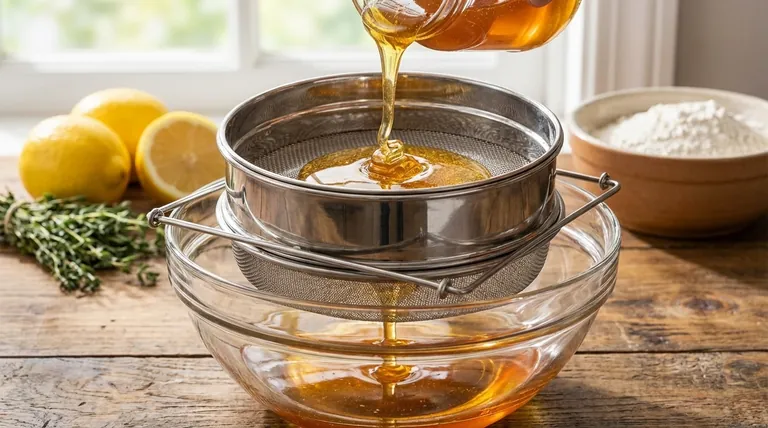In short, a steel strainer is a kitchen tool used to separate solids from liquids. Its primary function is to filter ingredients, whether for rinsing vegetables, creating smooth sauces and stocks, draining pasta, or sifting dry goods like flour. The stainless steel construction makes it exceptionally durable, heat-resistant, and hygienic.
The true value of a steel strainer lies not just in its separating function, but in its material. Stainless steel provides a level of durability, heat safety, and cleanliness that makes it a versatile and indispensable workhorse in any serious kitchen.

The Core Function: Precision Separation
A strainer's job is to act as a gatekeeper, letting liquids pass through while holding solids back. This simple mechanism is fundamental to a wide range of culinary techniques.
Removing Solids from Liquids
This is the most common application. It's essential for creating refined textures in sauces, stocks, juices, and purees by removing unwanted seeds, pulp, or lumps.
Pouring a finished stock through a strainer ensures a clear, professional-quality broth, free from small bones or vegetable fragments.
Rinsing and Washing
While a colander is used for large items, a steel strainer is perfect for smaller ingredients. Its fine mesh prevents tiny grains like quinoa or rice from washing down the drain.
It's also ideal for gently rinsing delicate produce like berries without bruising them.
Sifting Dry Ingredients
A steel strainer can double as an effective sifter. Running flour, powdered sugar, or cocoa powder through the mesh breaks up clumps and aerates the ingredients.
This process results in a lighter, more uniform texture in baked goods.
Why Material Matters: The Stainless Steel Advantage
The choice of stainless steel is not arbitrary; it provides critical benefits that directly impact its performance and safety in the kitchen.
Unmatched Durability
Stainless steel is highly resistant to corrosion, meaning it won't rust even with constant exposure to water and acidic foods.
Unlike plastic, it won't warp, crack, or stain over time, ensuring a long and reliable service life.
High-Temperature Tolerance
This is a key safety and performance feature. You can confidently pour boiling stocks, hot oils, or blanched vegetables directly into a steel strainer without fear of it melting.
This heat resistance prevents the leaching of harmful chemicals into your food, a potential concern with plastic alternatives.
Superior Hygiene
Stainless steel has a non-porous surface, which means it doesn't harbor bacteria or absorb odors and flavors from food.
This makes it exceptionally easy to clean and sanitize, either by hand or in a dishwasher, ensuring it remains a safe tool for food preparation.
Understanding the Trade-offs
While highly effective, it's important to understand the practical considerations of using a steel strainer.
Mesh Fineness
Strainers come in various mesh sizes. A fine-mesh strainer is excellent for silky-smooth purees but can be slow for draining large volumes of liquid.
A coarse-mesh strainer will drain pasta quickly but may let smaller particles pass through when making a stock.
Potential for Clogging
Fine-mesh strainers, in particular, can be difficult to clean if starchy or fibrous foods are allowed to dry in the mesh. It's best to rinse them immediately after use.
Making the Right Choice for Your Goal
Select a strainer based on its intended, most frequent use in your kitchen.
- If your primary focus is everyday cooking like draining pasta or washing vegetables: A medium-mesh stainless steel strainer offers the best balance of drainage speed and filtering.
- If your primary focus is baking or creating refined sauces and stocks: A fine-mesh strainer is non-negotiable for achieving a perfectly smooth, professional texture.
- If your primary focus is long-term value and food safety: Stainless steel is the definitive choice over any other material for its unmatched durability and hygienic properties.
Ultimately, a quality steel strainer is a foundational tool that brings control and precision to countless kitchen tasks.
Summary Table:
| Feature | Benefit |
|---|---|
| Stainless Steel Construction | Durable, rust-resistant, and long-lasting. |
| High-Temperature Tolerance | Safe for boiling liquids; won't melt or leach chemicals. |
| Non-Porous Surface | Hygienic, easy to clean, and doesn't harbor bacteria. |
| Versatile Mesh Sizes | Suitable for tasks from draining pasta to sifting flour. |
Ready to equip your kitchen or business with professional-grade tools?
HONESTBEE supplies durable, commercial-quality beekeeping supplies and equipment to apiaries and distributors through wholesale-focused operations. A well-equipped kitchen, like a productive apiary, relies on reliable tools built to last.
Contact us today to discuss your needs and discover how our products can bring superior performance and value to your operation.
Visual Guide

Related Products
- Stainless Steel Double Layer Honey Strainer Sieve Filters
- 10L Stainless Steel Electric Honey Press Machine
- Stainless Steel Manual Honey Press with Guard for Pressing Honey and Wax
- HONESTBEE 6 Frame Three Use Electric Honey Extractor for Beekeeping
- Stainless Steel Honey Press Wax Press with Tank
People Also Ask
- What is a honey sieve? The Key to Clean, High-Quality Honey for Your Apiary
- What makes polyurethane foam environmentally friendly? The Surprising Benefits of a Durable, Inert Material
- What are the key features of a double sieve honey strainer? Achieve Fast, Clean Honey Processing
- What mesh sizes are commonly used in double sieve honey strainers? Achieve Clean, Raw Honey Efficiently
- What is the best material for straining honey? Achieve Pure, High-Quality Honey with the Right Materials



















